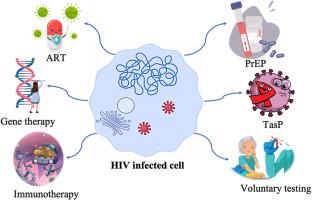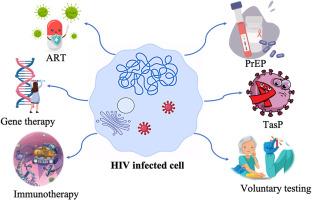从抗逆转录病毒药物到治愈性疗法:艾滋病毒治疗和预防的最新进展
IF 5.9
2区 医学
Q1 CHEMISTRY, MEDICINAL
引用次数: 0
摘要
人类免疫缺陷病毒(HIV)是一项重大的全球健康挑战。抗逆转录病毒疗法(ART)提供了有效的病毒抑制,但未能实现彻底治愈。终身抗逆转录病毒治疗因药物相关毒性、粘附障碍和潜伏病毒库的持续存在而进一步复杂化。近年来,创新的治疗策略已经出现,以解决这些限制。基于基因的方法,包括CRISPR/Cas9编辑、干细胞移植、延迟逆转或延迟沉默策略,正在探索直接靶向和消除病毒库。在免疫疗法、治疗性和预防性疫苗、暴露前预防(PrEP)和治疗即预防(TasP)方面的平行努力正在扩大预防和治疗战略。这篇综述总结了HIV治疗的发展,强调了这些不同方法的最新进展,并讨论了它们重塑未来治疗的潜力。我们还概述了当前的挑战和研究重点,特别是在消除水库、安全和可扩展的输送平台以及确保资源有限环境下的可及性方面。这些创新共同为功能性治愈战略提供了有希望的途径,并有助于到2030年结束艾滋病毒流行的全球努力。本文章由计算机程序翻译,如有差异,请以英文原文为准。


From antiretrovirals to curative therapies: Current developments in HIV treatment and prevention
Human immunodeficiency virus (HIV) is a major global health challenge. Antiretroviral therapy (ART) provides effective viral suppression but falls short of achieving a definitive cure. Lifelong ART is further complicated by drug-related toxicities, adherence barriers and the persistence of latent viral reservoirs. In recent years, innovative therapeutic strategies have emerged to address these limitations. Gene-based approaches, including CRISPR/Cas9 editing, stem cell transplantation, and latency-reversing or latency-silencing strategies are being explored to directly target and eliminate viral reservoirs. Parallel efforts in immunotherapy, therapeutic and preventive vaccines, pre-exposure prophylaxis (PrEP), and treatment as prevention (TasP) are expanding the preventive and therapeutic strategies. This review summarizes the evolution of HIV therapies, highlights recent advances across these diverse approaches and discusses their potential to reshape future management. We also outline current challenges and research priorities, particularly regarding reservoir eradication, safe and scalable delivery platforms, and ensuring accessibility in resource-limited settings. These innovations together offer promising avenues toward functional cure strategies and contribute to the global effort to end the HIV epidemic by 2030.
求助全文
通过发布文献求助,成功后即可免费获取论文全文。
去求助
来源期刊
CiteScore
11.70
自引率
9.00%
发文量
863
审稿时长
29 days
期刊介绍:
The European Journal of Medicinal Chemistry is a global journal that publishes studies on all aspects of medicinal chemistry. It provides a medium for publication of original papers and also welcomes critical review papers.
A typical paper would report on the organic synthesis, characterization and pharmacological evaluation of compounds. Other topics of interest are drug design, QSAR, molecular modeling, drug-receptor interactions, molecular aspects of drug metabolism, prodrug synthesis and drug targeting. The journal expects manuscripts to present the rational for a study, provide insight into the design of compounds or understanding of mechanism, or clarify the targets.

 求助内容:
求助内容: 应助结果提醒方式:
应助结果提醒方式:


